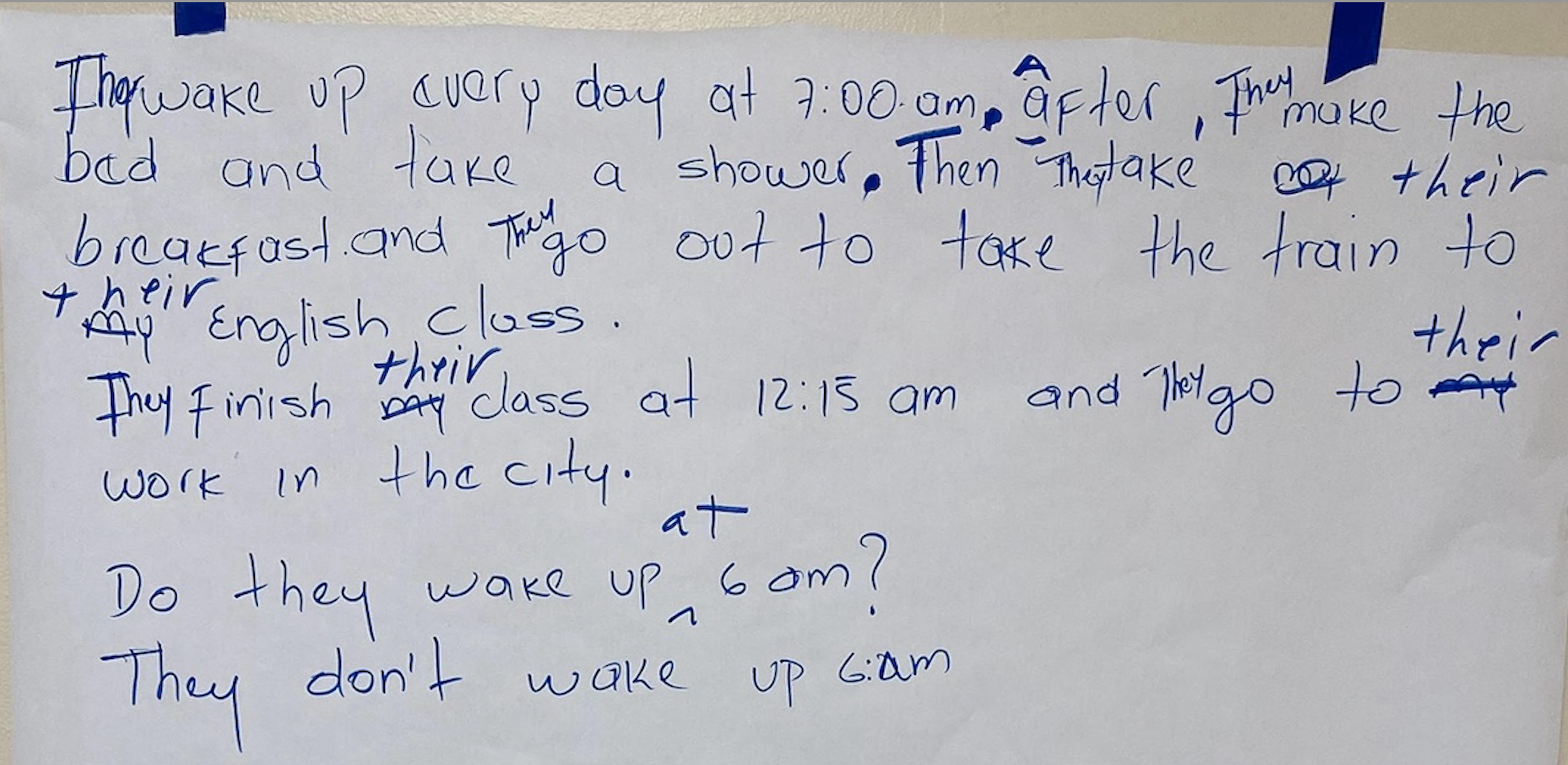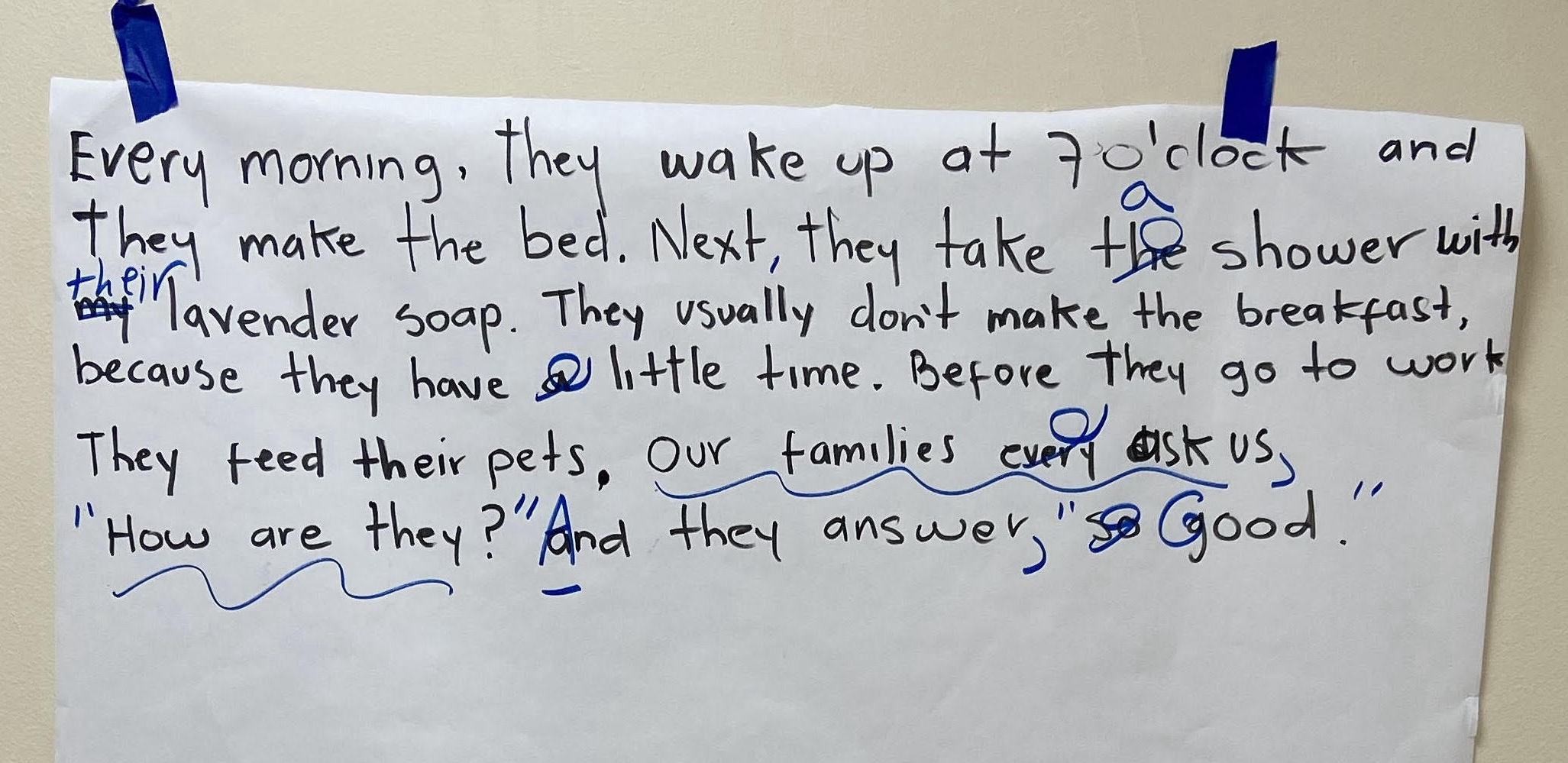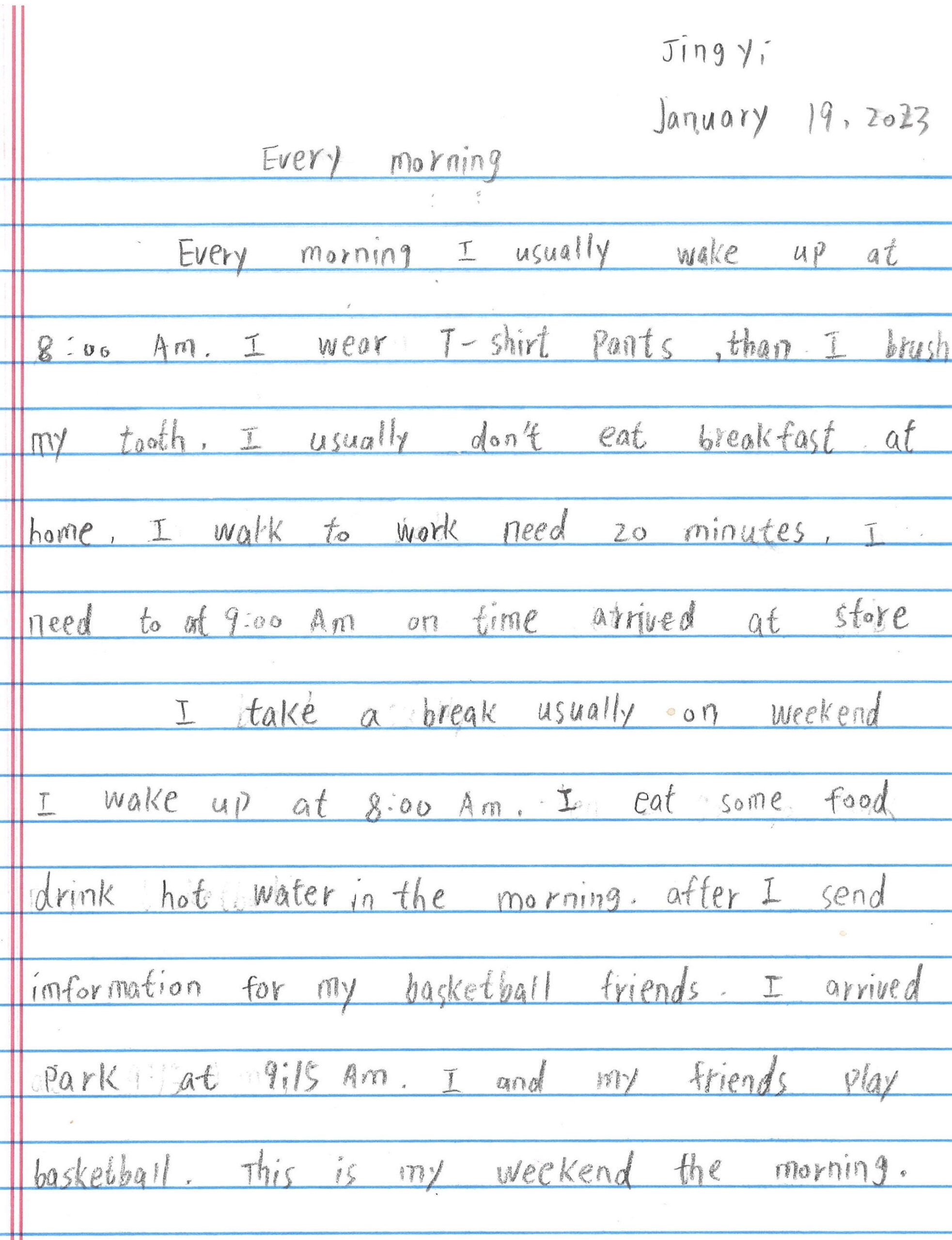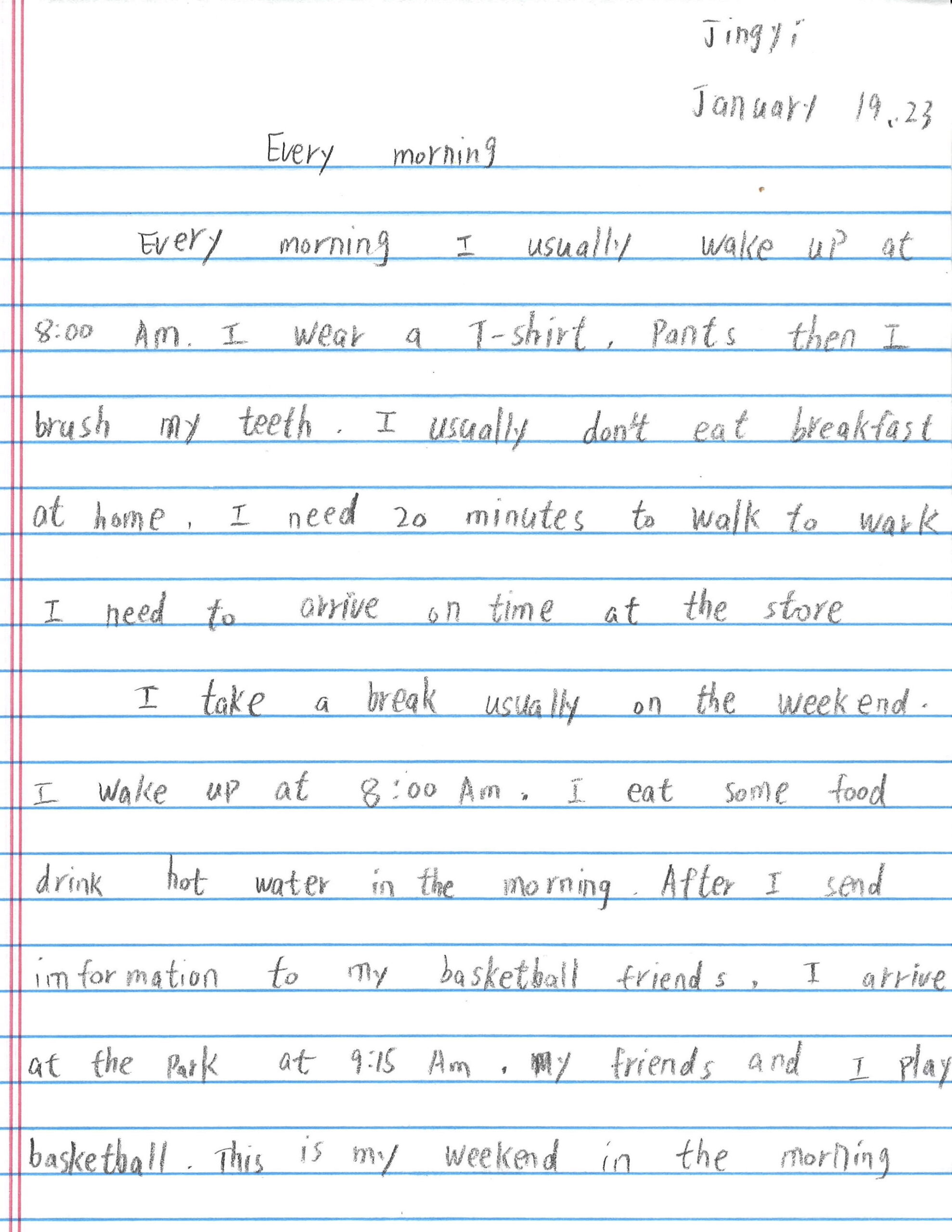What follows is a lesson plan introducing High Beginner ESL students to the Present Tense, the simple present and the present progressive. The activities are for both group and individual work. And the answers are given for the exercises. There is a printable PDF.
PDF (printable):
Every Morning Simple Present
1. Every Morning
I feed my cat and give him fresh water. I brush his fur too. While I’m brushing him, he purrs and rubs himself against my hand. He is happy and so am I. There is a feather on a string that he likes to play with. I also throw him a toy mouse that he catches and brings back in his mouth. I always throw the mouse to him when I leave for work. It’s my way of saying, “I’ll see you. Have a great day.”
Make a list of all the parts of speech you see in the story:
Pronouns Nouns Adjectives Main Verbs
Helping Verbs Adverbs Prepositions Conjunctions
Some thoughts about the Present Tense: the Simple Present, the Present Progressive, and the helping verb To Be:
The Simple Present: Do and Does + Base Form
Yes: The cat catches the feather.
No: The cat doesn’t catch the feather.
Yes/No Question: Does the cat catch the feather?
For Certain: The cat does catch the feather.
Am, Are, Is
Yes: The cat is happy.
No: The cat isn’t happy.
Question: Is the cat happy?
Present Progressive: Am, Are, and Is + ING
Yes: I am feeding the cat.
Question: Are you feeding the cat?
Contraction: She isn’t feeding the cat.
No: They are not feeding the cat.
2. Exercises
Exercise One: Change the yes sentences to no sentences.
I feed my cat.
I’m brushing him, and he is purring.
We are playing catch.
He brings the toy in his mouth.
We love to play.
We are happy.
Exercise Two: Change the yes sentences to yes/no questions.
I feed my cat.
I’m brushing him, and he is purring.
We are playing catch.
He brings the toy in his mouth.
We love to play.
We are happy.
3. Student Activity: Group work
In a group, write a paragraph in the present tense about what people do every morning.
Every morning, people…
4. Student Activity: Individual Work
Write a paragraph in the present tense about something you do every morning.
Every morning, I…
Lesson Plan for “Every Morning”
The Objective:
In this exercise, the class will examine the present tense in English. There are twenty helping verbs in English that give main verbs their number and tense. There are five helping verbs that help the main verbs in the present: Do, does, am, are is.
Every main verb in English has three principle parts. If we look at walk, there is:
Walk (the base form), Walking (the ING), Walked (the Participle).
If we look at eat, there is:
Eat (the base form), Eating (the ING), Eaten (the Participle).
What students will understand is that the helping verbs, Do, Does, Am, Are, and Is help the Base Form and the ING in the Simple Present and the Present Progressive.
Simple present:
She walks to work (does hidden).
She doesn’t walk to work (does seen).
Does she walk to work (does seen)?
She does walk to work (does seen).
Do and does often remain hidden in the simple present yes sentences.
Present Progressive:
She is walking to work.
She isn’t walking to work.
Is she walking to work?
Am, are, is are always seen.
Some talk about the hidden Do and Does:
Not only will students become familiar with the Simple Present and the Present Progressive, they will understand in the exercises, that in the simple present yes sentence, the helping verbs do and does are usually hidden:
I love you. I (do) love you.
She eats pizza. She (does) eat pizza.
But Do and Does always appear in the negative, the yes/no question, and the for certain sentences:
I don’t love you.
Do I love you?
I do love you.
She doesn’t walk to work.
Does she walk to work?
She does walk to work.
Writing in Groups and Alone.
Writing in Groups and Alone. Students will work together to create a paragraph about “What People Do Every Morning.” Then students will work alone and write a paragraph about “What I Do Every Morning.”
Students will begin to understand how sentences work.
The Materials:
Handouts (or PDF projected onto whiteboard)
Lined paper
Dry markers for white board
The Lesson:
1. With the teacher, the students go over the Handout “Every Morning.” This can be a printed handout. Or if possible, it can be projected from a computer onto the white board.
2. In groups of three, students do Exercises One and Two. Each group writes several of their answers on the white board. When they are finished, the teachers goes over their work making any corrections.
Writing in a Group
3, A. Remaining in their groups, groups discuss and write a paragraph of what people do every morning. At least five sentences. Each group writes their paragraph on newsprint and hangs it up.
3, B. With the teacher, the class looks at the paragraphs the students have written and hung up, and the teacher models making corrections. A handout of correction marks can be given to the students.
Writing Individually
4, A. The teacher hands out a piece of line paper and tells each student to write a paragraph about what they specifically do every morning. Because the students have already done the exercises, they should have enough vocabulary to work with.
4, B. The students give their first drafts to the teacher, and the teacher, with the student present, goes over the essay and makes corrections.
4, C. The teacher gives the first draft with corrections back to the student, and another sheet of lined paper. The student writes draft two and shows it to the teacher. With the student, the teacher goes over draft two, makes corrections, and gives it back to the student.
End of Lesson.
…
Answers to the Activities:
Listing the Parts of Speech:
Changing Yes Sentences to No Sentences:
Changing Yes Sentences to Yes/No Questions:
Some Examples of Student Work:
In the photos below, students are writing Negative Sentences and Yes/No Questions. I projected the prompt sentences on the whiteboard. If a projector is not available, the teacher can print out the PDF above and print copies for the students. If printing is not available, the teacher can simply write the prompt sentences on the whiteboard, or whatever is available. The teacher can also read the prompt sentences to the students who can be working in groups or doing the exercise individually. Reading the sentences to the students will improve their listening skills.
Two examples follow of students working in groups writing a paragraph: What People Do Every Morning. Corrections marks by the teacher were added when going over each paragraph with the class.
An example of one student’s writing is below. The first draft is first. Then the corrections marks done by the teacher with the student. And then the second draft by the student following the corrections.











